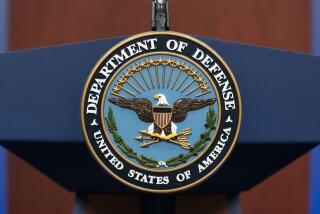U.S. Plays Down Naval Buildup Off Lebanon
- Share via
WASHINGTON — The White House cautioned Wednesday against speculation that military action is imminent in the Middle East’s continuing hostage crisis despite the gathering of a larger-than-usual U.S. naval force off the coast of Lebanon.
Pentagon officials said a five-ship amphibious assault force carrying helicopters and 1,900 Marines is en route from Spain to join a flotilla of about 30 other ships, including two aircraft carriers, now operating in the eastern Mediterranean.
The Navy usually maintains about 25 combat ships in the region, said one source, who described the deployment of additional ships as precautionary.
Speculation Discouraged
White House spokesman Marlin Fitzwater, while not ruling out the possibility of a military strike, sought to discourage such suggestions.
“I can’t speculate on any future course of action,” Fitzwater said in response to questions. “We always do have substantial forces in the area, but I would urge not to speculate along those lines.”
At another point during the White House briefing, he said that “I would urge a little downgrading of the speculation” that the marshaling of naval forces foreshadows military action.
“Our forces are there on what in many ways is normal activities and operations. . . . The forces are there to protect our strategic interests and to support our friends in the region,” he said, urging reporters not “to jump to any conclusions about any military activities.”
The buildup of U.S. forces in the area began in recent weeks when a new wave of kidnapings increased to eight the number of Americans believed held hostage by terrorists in Lebanon.
The carrier battle group consisting of the flattop John F. Kennedy and two cruisers, three destroyers, four frigates and two support ships had been scheduled to leave the Mediterranean last week, but those plans were canceled. The carrier is now scheduled to make a port call this weekend in Haifa, Israel, about 60 miles south of Beirut.
90 Planes Per Carrier
Another carrier battle group, headed by the Nimitz and accompanied by two cruisers, two destroyers, five frigates and two support ships, also is operating in the eastern Mediterranean. Each of the carriers has about 90 planes, mostly F-14 Tomcat jet fighters and A-6 Intruder attack jets.
The five-ship amphibious force now en route to the eastern Mediterranean will join three other amphibious ships, also carrying 1,900 Marines, which sources said were originally scheduled to return to the United States.
Naval forces in the Mediterranean are under the command of Vice Adm. Kendall E. Moranville, commander of the 6th Fleet, who is on his flagship, the guided missile cruiser Belknap.
Administration officials have been cautious in describing ship movements. Chief Pentagon spokesman Robert B. Sims, for example, said Tuesday that the movements “are cautionary in nature. . . . It is prudent to do so, given the increase in tensions in the area . . . and to allow the President to examine the full range of options available to him.”
Contingency Plans Updated
Other sources, while stressing that no orders have been issued to the naval force to prepare for an attack, said contingency plans are being constantly updated for possible action against terrorist camps and training sites in Lebanon’s Bekaa Valley, as well as in such countries as Syria and Libya.
One extremist group, Islamic Jihad (Islamic Holy War), has warned that American and other hostages will be killed “in case of any military attempts against Muslims in the area and especially in Lebanon.”
More to Read
Sign up for Essential California
The most important California stories and recommendations in your inbox every morning.
You may occasionally receive promotional content from the Los Angeles Times.










